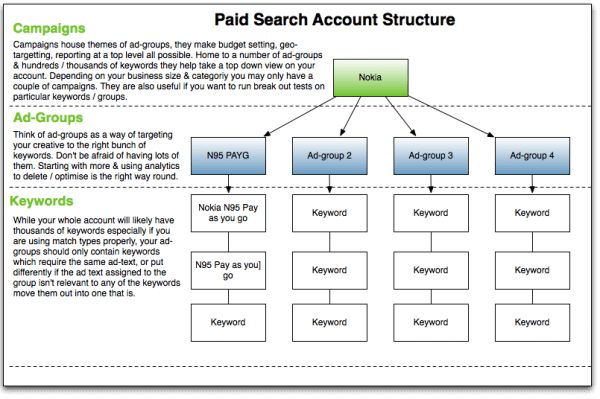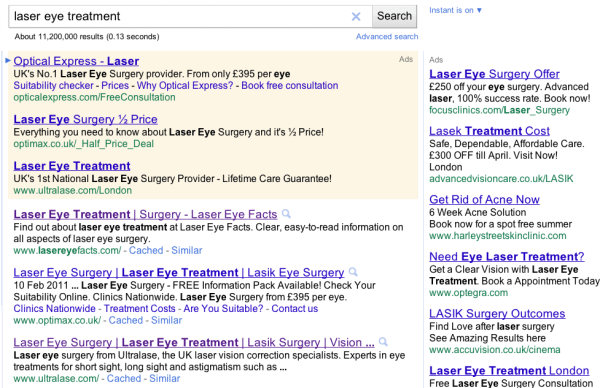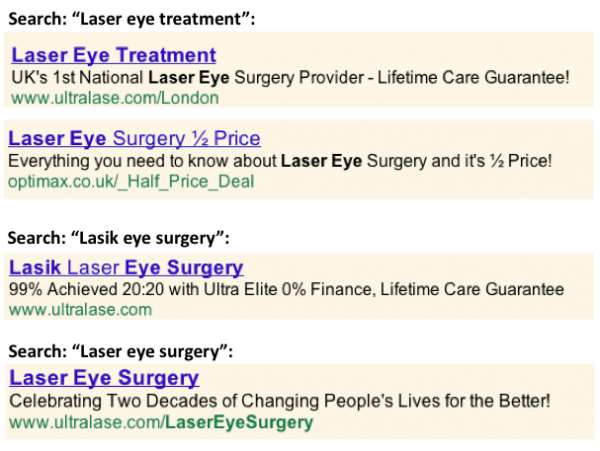A "back to basics" guide on targeting Pay Per Click through campaign structure setup
What do we mean by campaign structure?
Campaign structure is the way in which your keywords are grouped within your paid search advertising account like Google Adwords or Bing/Microsoft adCenter.
The example below shows how it's important to have a specific Ad Group for each model of a mobile phone and only related keywords within there.

They help define the appropriate ad creative to be displayed when these terms are searched for.
Because creative for searches and the keywords that triggers ads are set at an Ad group level it is all too easy to have adverts that are not targeted towards the keyword searched for if you put a number of unrelated or even subtly different keywords in an Ad Group.
This ultimately means relevance will be low, so your click-through rate will be low and your price will have to be high. Not a good place to be.
Here's an example of how keyphrase targeting can go wrong and cost you money. It's from the ultra-competitive laser eye treatment market where a single cost-per-click can be more than £10. For the search phrase "laser eye treatment" the top two examples don't use the word "treatment" in their ad. So they are likely paying a higher CPC than they need (although the copy is effective so this will boost their clickthrough rate and so their quality score).

In the third position above, Ultralase matches their ad, using campaign structure to the search term by having the triggering keyword "laser eye treatment" within the ad group for this creative.
If we look at other keyphrases we see that the ad creative updates to reflect the new search term:

This is a simple audit we suggest you do for your main keyphrases, also looking for the strength of the creative and marketing offer within the messages.
What happens if I don’t get it right?
In a nutshell, it will cost you more to get less.
Getting the structure of the account right (or wrong) impacts:
- Your Quality Score (and therefore...)
- Impressions (you will get shown less as a result of a low relevance score)
- Clicks (less people will click on your ad due to irrelevant text ads)
- Cost (increases due to having a low quality score)
- Conversion rates (due to people ending up on a less relevant landing page on your site)
Campaign structure is vitally important since it determines how closely you can target your paid search activities. If you have many diverse keywords for an ad you will be less able to deliver relevance. For example, if you are a phone retailer, it doesn’t make sense to serve the same ad regardless which phone model the searcher is looking for, instead you need specific Ad Groups in Google that give a different message according to the product or service sought and the qualifier used to narrow down the search. If you have tens or even of hundreds of keywords in each Ad Group, you are almost certainly providing less targeted ads than the supplier who has more Ad Groups each contain a smaller number of words.
Why do so many people get it wrong?
Account structure is usually something a search agency will tell you is wrong when they take over accounts. A lot of it comes down to opinion & how they prefer to work. There is no formula that works for every business. There are however common traits in attitude, approach & skills that you can influence to improve your chances of running successful campaigns. Here are 4 top level things that impact campaign structure in no particular order that I have learnt in my 6+ years in paid search:
- Consider your customer over management & automation
- Consider customer journeys & what they want when putting keywords & creative into their groups
- Use analytics to refine & improve the campaign structures & management efficiency of the account over time. You will not get it right first time round & you will “burn cash” to get the data needed to eventually get it right for your business
- Ensure you have the right skills when creating / editing the campaign structure. Paid search attracts very logical, mathematical & technical people due to its possible complexity and volume of data. While these skills are important someone who can remove themselves from systems & instead think like a consumer to be the one to test the “logic” of everyone else
How can I ensure I don’t get it wrong?
The honest answer is you can’t, however taking my points above into account, using any data you have on previous performance and taking the time to really think it through should ensure you end up on the right path and don’t have to reinvent everything all the time.
Try using bits of paper to re-create the account structure and play with what sits where and question that with other members of staff before embarking on any implementing anything new.
Further Resources for your Paid Search Account Structure









